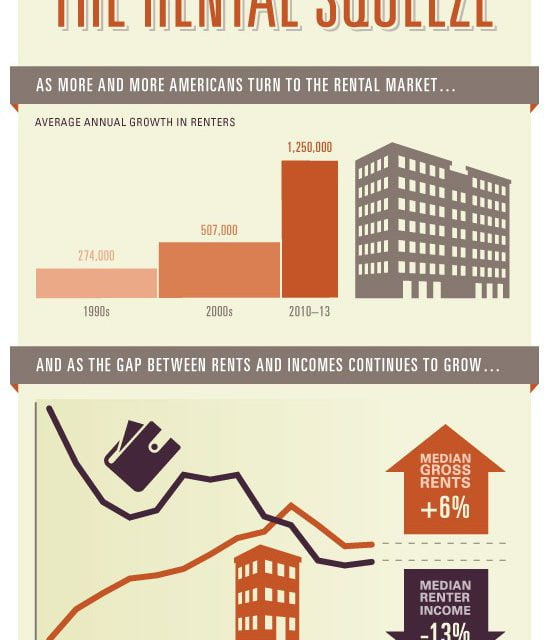Infographic courtesy Harvard University
Harvard University has declared there’s a “squeeze” on the rental market. Rising rents and stagnant wages in the U.S. have created the largest group of cost-burdened (paying more than 30% of their gross income) renters in over a decade, according to a recent report from the Harvard Joint Center for Housing Studies.
Half of U.S. renters now pay over 30% of their gross income in rent. The cost-burdened renter population has increased by 12 percentage points since 2000, with the greatest increase found among those who pay more than half their gross income in rent. This group, dubbed the severely cost burdened, comprises 27% percent of all cost burdened renters.
The study found median national rents rose 6% between 2000 and 2012, while the median income fell 13%. This crunch comes at a time when more Americans are renting their shelter. The share of Americans who rent increased from 31% in 2004 (as the housing bubble was gaining steam) to 35% in 2012. As the homeownership rate fell from its dizzying highs in the Millennium Boom, the share of renters naturally increased.
This trend has been particularly problematic for California. Our homeownership rate fell precipitously from its 2006 peak of 60.1% to today’s low of 54.4%. As the homeownership rate continues to decline, California’s rental vacancy rate declines in turn, increasing competition and thus the cost of rent.
California wages have also fallen. Real (inflation-adjusted) California median household incomes decreased from their pre-recession height of $66,386 to a continuously declining low of $58,328 in 2012. Per capita income in California has fallen over 5% since 2010.
At the same time, rents in California’s metro regions continue to rise. The average rent in San Francisco is three times higher than the national average; it rose 10.6% in December. San Diego rents jumped 9.5% in December and L.A. saw a more modest 2.1% increase, according to Trulia.
How are both rents and prices rising while wages fall? And all while interest rates increase?
Well, we’ve deemed 2014 a year of adjustments for a reason. This mess in the rental market is a perfect example. Investors have dumped huge sums of cash on single-family residences (SFRs) while builders (until recently) have been either loath or unable to build.
Since implied rents have increased with artificially inflated home prices, landlords have been pushing rents to the absolute limit. Many investors have become landlords of necessity since they’ve been unable to flip their recent purchases for a profit. They push the rent horizons higher to try and eek out a net profit from their hasty, over-priced purchases.
Couple this phenomenon with a micro-boom in the highly specialized Silicon Valley and (smaller scale) San Diego tech markets and you have a recipe for inflated rents and prices. This makes a very tough go for those who lack the opportunity or desire to work in high tech. That includes the thousands who have dropped out of the labor force and no longer show up in the now falling unemployment rate.
We hope this year of adjustments will eventually find some semblance of equilibrium. Prices cannot continue to rise in the face of rising interest rates and the persistent lack of real demand, right? Builders have begun to create more supply, especially in the multi-family market, which will bring apartment rents down, forcing single family residence (SFR)-laden speculators to lower their rents in order to compete.
The deep concern is that the continued inflation of rents and home prices has already created a period of secular (long-term) stagnation. A vicious, regressive economic cycle known as hysteresis may be occurring in the California real estate market. The longer individuals are prohibited from real estate market participation, the longer they devote the lion’s share of their income to rent rather than savings or consumer spending, the longer this cycle of economic stagnation continues.



















